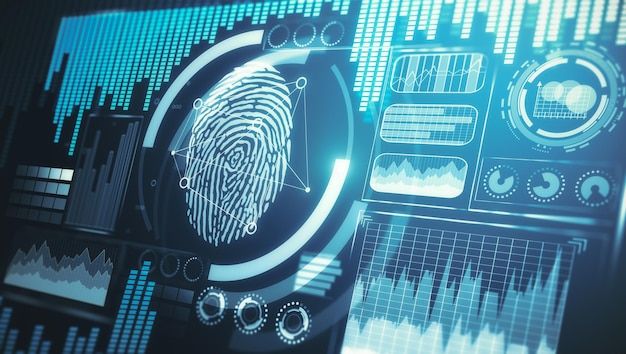In today’s interconnected world, our lives are increasingly mirrored in the digital realm. Every online transaction, social media post, and email we send contributes to a virtual representation of who we are—our digital identity. This identity is a complex tapestry of personal information, from our names and birth dates to our online behaviors and financial data. While this digital existence offers unparalleled convenience, it also exposes us to a myriad of threats, making the protection of our digital identity a critical skill for navigating the modern world. This article serves as a comprehensive guide to understanding these threats, identifying the key vulnerabilities, and implementing proactive strategies to safeguard your most valuable asset: your online self.
The importance of protecting your digital identity cannot be overstated. A compromised identity can lead to devastating consequences, including financial loss, damage to your reputation, and legal trouble. Cybercriminals are constantly evolving their tactics, from simple phishing scams to sophisticated ransomware attacks, all with the goal of stealing your data. The battle for digital identity protection is not just a technological one; it’s a constant, vigilant effort that requires a combination of awareness, smart habits, and the right tools. By understanding the landscape of digital threats and taking intentional steps to secure your data, you can significantly reduce your risk and maintain control over your online life.
A. Understanding the Threats to Your Digital Identity
To effectively protect yourself, you must first understand what you’re up against. The threats to your digital identity are varied, ranging from large-scale data breaches to targeted, personal attacks.
A. Data Breaches and Major Lapses: In our data-driven society, we entrust our personal information to countless companies, from social media platforms to e-commerce sites. When a company’s database is hacked, it can expose millions of user records at once. These breaches are often out of our control, but the information they expose—such as email addresses, passwords, and even credit card numbers—can be used by cybercriminals for a variety of nefarious purposes. A single major data breach can have a domino effect, as criminals may use the stolen data to gain access to other accounts you hold.
B. Phishing and Social Engineering: This is a tactic that preys on human psychology rather than technological vulnerabilities. A phishing attack involves an attacker impersonating a trusted entity—like a bank, a government agency, or a familiar company—to trick you into revealing personal information. Phishing can be carried out through fake emails, text messages, or even phone calls. The goal is to create a sense of urgency or fear, prompting you to click a malicious link or provide sensitive data without thinking. Phishing is a gateway to further identity theft.
C. Malware, Spyware, and Ransomware: These are malicious software programs designed to infiltrate your devices.
- Malware: A broad term for malicious software, including viruses and worms, that can corrupt your files, slow down your system, or compromise your data.
- Spyware: A type of malware that secretly monitors your activity and collects information, such as your keystrokes, browsing history, and passwords. It can capture sensitive information without you even knowing it’s happening.
- Ransomware: This is a particularly nasty form of malware that encrypts your files, making them inaccessible. The attacker then demands a ransom payment, usually in cryptocurrency, to restore access. Even if you pay, there is no guarantee that your data will be returned.
D. Public Wi-Fi Vulnerabilities: While public Wi-Fi is incredibly convenient, it can also be a significant security risk. Unsecured public networks are often easy for hackers to exploit, allowing them to intercept your data as it travels between your device and the internet. This can expose everything from your browsing history to your login credentials, making it a dangerous environment for conducting sensitive transactions like online banking or shopping.
B. Building Your Digital Fortress: Key Protection Strategies
Protecting your digital identity requires a multi-layered approach. No single tool or practice can guarantee complete security, but by combining these strategies, you can build a strong defense.
A. Mastering Password Security: Your password is the first and often only line of defense for your accounts. A weak password is an open invitation for a hacker.
- Use a Password Manager: This is the most effective way to manage your passwords. A password manager generates strong, unique passwords for each of your accounts and stores them securely. This means you only have to remember one master password.
- Enable Two-Factor Authentication (2FA): Also known as multi-factor authentication, 2FA adds a second layer of security. After entering your password, you must provide a second piece of information, such as a code sent to your phone or a biometric scan (fingerprint or facial recognition). This makes it exponentially more difficult for a hacker to access your account, even if they have your password.
B. Securing Your Devices and Network: Your devices are the main points of entry for most cyber threats.
- Keep Your Software Updated: Software updates often contain critical security patches that fix vulnerabilities. Ignoring them leaves you exposed. Make sure your operating system, web browser, and all applications are up to date.
- Install Antivirus/Anti-Malware Software: A reputable security suite can provide real-time protection, scanning for and removing malicious software before it can do any harm.
- Use a VPN on Public Wi-Fi: A Virtual Private Network (VPN) encrypts your internet connection, creating a secure tunnel for your data. When you’re using public Wi-Fi at a cafe or airport, a VPN is an essential tool to prevent hackers from intercepting your information.
C. Practicing Smart Online Habits: Your own behavior is one of the most powerful tools in your cybersecurity arsenal.
- Be Skeptical of Links and Attachments: Never click on suspicious links or download attachments from unknown senders, even if they appear to be from a trusted source. Always verify the sender and the context of the message before taking any action.
- Limit Personal Information Sharing: Be mindful of what you share on social media. Information like your birthday, hometown, and pet’s name are often used as security questions or for guessing passwords. The less public information you have online, the harder it is for a criminal to impersonate you.
- Review Privacy Settings: Regularly audit the privacy settings on all your social media accounts and apps. Make sure you understand what information is being collected about you and who it is being shared with.
C. The Future of Identity Protection: Proactive Measures and Emerging Trends
The battle for digital identity protection is constantly evolving. As technology advances, new threats and new defenses will emerge. Staying ahead of the curve is key.
A. Blockchain and Decentralized Identity: Current digital identity systems are centralized, meaning a single company or government holds all of your data. This makes them a prime target for hackers. The concept of decentralized identity, built on blockchain technology, aims to change this. It would allow you to control your own identity data, sharing only the information necessary for a transaction, without relying on a central authority. For example, instead of sharing your date of birth, you could use a blockchain-verified credential to simply prove you are over 18.

B. Biometrics and Beyond: While passwords are a key part of security, they are not foolproof. Biometric authentication, which uses unique physical traits like your fingerprint or face, is becoming a standard for securing smartphones and other devices. In the future, this may be combined with other factors, such as your location or even your unique typing rhythm, to create an even more robust authentication system.
C. The Role of AI in Cybersecurity: Artificial intelligence is being used on both sides of the cybersecurity battlefield. Hackers are using AI to create more sophisticated phishing scams and malware. However, cybersecurity firms are also using AI to detect and prevent threats in real-time. AI can analyze network traffic for suspicious patterns and identify new threats before they can cause widespread damage, providing a critical layer of defense in a world of ever-evolving attacks.
In conclusion, our digital identities are not just a convenience; they are an essential part of who we are, and protecting them is a shared responsibility. The threats are real and ever-present, but so are the tools and strategies to combat them. By understanding the risks, implementing strong security practices, and staying informed about new technologies, you can take control of your online presence. Your digital identity is a valuable asset; treat it as such and protect it with the care it deserves.













